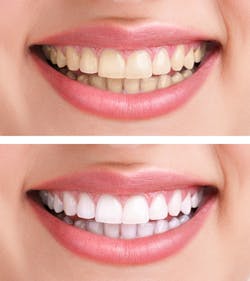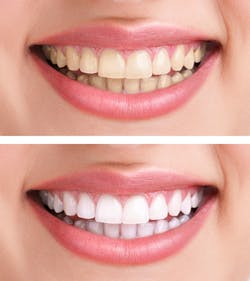Whitening SOP: Protocol for smile evaluation engages patients
By Kristine A. Hodsdon, RDH, MSEC
Teeth could be falling out of some patient’s mouth, and yet they look up at you earnestly and ask, “Can they be whiter?” Research tells us people make decisions less about their clinical needs and more about what motivates them—intrinsically and extrinsically. In my role as a practice coach, I am often asked, “How do we discuss whitening without seeming pushy or sales-y with our patients who do not inquire?”
Answer: An assessment protocol that creates an environment for increased whitening acceptance. This article will provide a framework for creating a standard of care for a whitening (smile or esthetic evaluation) protocol to be utilized during recare and or restorative visits.
The smile evaluation is a simple form with questions, a checklist, and/or images that reflect how they feel about their teeth. It takes about 60 seconds. Upon patient check-in, the administrative team can hand the patient this form along with the other necessary paperwork. Alternatively, if your office is paperless, another option is to provide the smile evaluation on a secure iPad. Once completed, it can be uploaded with all the updated information directly into the patient’s chart and waiting for the hygienist to review.
Second, each operatory should be equipped with shade guides. Set the guide up from lightest to darkest. Make sure the shade guide also includes the newer “bleaching” colors.
Third, the hygienist can give the patient a mirror and or take extraoral photos. With the patient looking into the mirror or the computer monitor that displays their images, simply say, “We now know that teeth can change color over time. On a yearly basis, similar to the periodontal examination, we record the shade of our patients’ teeth. What I would like to do now is to determine the current color of your teeth. I will need your help with this part.”
This immediately gets the patient involved in their care and gives you further opportunity enroll them in your whitening services.
Hold the shade guide so that your patient can see the colors. Next, have the patient guide the selection of the shade. This gives him/her an idea of what his or her teeth could look like.
At this point, you may say, “Other than the color shifts, is there anything else that you notice about your smile?” Or, say nothing. You will be amazed at how many patients voluntarily ask about the lighter shades on the guide without any prompting or voluntarily point out their smile discrepancies. It is possible that some patients will tell you they never thought it was possible to get whiter teeth; either they thought it would be too expensive or thought that whitening was not an option for their teeth. So, by standardizing this process, you have engaged the patient in their care, which will lead to connection and trust and ultimately increased case acceptance. Finally, choose the appropriate shade to be recorded in the patient’s record (for example, an anterior tooth and canine).
The smile SOP supports serving your patients at the highest level and moving forward with their desire to have whiter teeth immediately. That means providing same day whitening services. This service will not only save the patient the inconvenience of having to take more time off to come back to your office for another appointment; it will:
- Increase your daily profitability
- Enhance your brand identity
- Increase referrals by turning your patients into practice advocates within your community.
Whitening products and systems have come a long way since the first documented treatments in 1872. As a consultant, I want to ensure my clients and potential clients are aware of the newer delivery models available for your patients whitening demands. For example, whitening systems as Sheer White Whitening Strips System is a game changer regarding enhancing patient’s smiles. Not only can patients’ benefit from having their teeth up to eight shades lighter, the easy to implement service can be completed chairside in minutes for a true post-prophy whitening experience!
The Sheer White In-Office strips eliminate the time and burden of the hygienist having to schedule a second appointment or find someone to take impressions and pour models. The strips prevent the patient from having to wear “gaggy” trays. Sheer White has the same mode of action as “traditional tray application” yet it is a direct replacement for custom trays, which equates to increased efficiency, productivity, and practice profitability. Best of all, your patients benefit from whiter teeth while they get back to work or play!
The purpose of this article is to provide a whitening framework of care that can be easily integrated into your current clinical assessments and standard operating procedures. Reach out to your Henry Schein representative, or visit www.sheerwhitestrips.com to request a free sample of Sheer White! Take-Home.
For the most current dental headlines, click here.
Kristine A. Hodsdon, RDH, MSEC, mentors female professionals to earn more by building profitable businesses and/or confidently advancing in their careers. She is an award winning international speaker, author, and consultant. To learn more about her coaching program for women entrepreneurs, or to receive her Feminista Living e-zine, visit www.kristineahodsdon.com.
Disclaimer: This article was made possible by an educational grant sponsored by CAO Group.
Resources
- ADHA Policy Manual - American Dental Hygienists Association Available at https://www.adha.org/resources-docs/7614_Policy_Manual.pdf. Accessed July 15, 2016.
- American Dental Association Tooth Whitening/Bleaching: Treatment Considerations for Dentists and Their. Patients. Available at: https://www.ada.org/~/media/ADA/About%20the%20ADA/Files/ada_house_of_delegates_whitening_report.ashx. Accessed July 16, 2016.
- Haywood VB: Nightgaurd vital bleaching: a history and products update. I. Esthet Dent Update 2 (4):63-66, 1991.
- Hodsdon K. Chapter 36, Esthetics in Daniel S, Harfst S, Wilder R (eds.) Mosby’s dental hygiene concepts, cases and competencies, 2nd ed. Mosby Elsevier, 2008.

